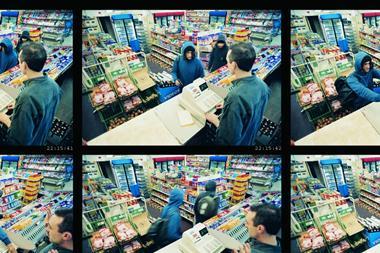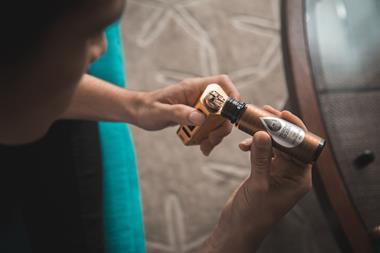Point of sale material (POS) is without doubt an essential tool for communicating with your customers. But with so many options available, choosing the right type for your store and knowing how to position it in the correct manner can be tricky. "The high street is tough and you need to stand out from the competition," says Mariana Wilkins, head of POS supplier, the Retail Marketing Department. "But don't use posters like wallpaper a lot of customers don't see messages because there are too many signs conflicting with one another."
Retailer Dan Cock, who owns Whitstone Village Stores in Holsworthy, Devon, is fully aware of the dangers of overdosing on POS. "You don't want to go overboard," he says. "It's no good if you can't see through the shop window because there are too many posters in the way."
Dean Holborn of Holborns in Redhill, Surrey, is also wary of cluttering his store. "We don't put posters in the doors as it prevents people looking into the store."
One option for retailers who aren't keen on window posters is pavement signs. "A-boards are very worthwhile," claims Wilkins. "I have a small c-store near me that has just lost its post office and has moved into food to go to compensate for the lost income. It has been very successful in using an A-board to advertise that it now offers freshly made sandwiches and soups for the nearby office workers."
However, it's best to check the rule book before investing in a street sign, advises UK Point Of Sale sales and marketing director Debbie Jamieson. "Most councils will have details if there are restrictions stores need to approach them to find out what the rules are."
And if pavement signs aren't an option, then she states that stores simply must consider window signage. "Everyone needs something outside the store because competition is so strong at the moment and you need to get your message across to consumers."
Wilkins suggests keeping posters to the side of your window. "Typically, it's better to have the poster on one side of the store so as not to block the view into the outlet," she says. "Stand outside the store and see which direction footfall is heaviest and ensure that the poster is clearly visible when walking that way."
Once you have pulled customers into your store, it is still important not to overwhelm them with too many deals. "In each area you should have only one key promotion," says Wilkins. "If you give people too much choice, they won't be bothered with any of it."
This viewpoint is echoed by Jamieson: "Less is more it gives more of a direct message if there's just one special offer, rather than bombarding customers," she says. "In small independents where space is limited, they can flag up gondola offers on shelf-talkers."
Dan agrees that shelf-talkers are very useful. "And shelf wobblers are good in moderation. For example, if there's a new product then it's handy to flag it up," he says.
Dean is also a fan of shelf-edge labelling, but doesn't feel that wobblers are particularly efficient. "I don't like shelf-edge wobblers they mess up the units and leave marks on the ticket edge. They also obstruct the view of other products and often fall off and I end up putting them in the bin."
Nevertheless, Jamieson claims that retailers can get wobblers to work for them. "There are different types of shelf wobblers PVC strips, adhesive strips, springs and so on. You need to make sure you pick the right material and have the right proportion of end message to strip, otherwise the weight will pull down your wobbler and it won't stand out."
If you haven't the time or patience for wobblers, then there are other options. "You should keep POS at eye level and grab level and use hot spots carefully," says Wilkins. "An A4 poster in a perspex display stand by the counter is a good idea.
"The key message at the till isn't difficult to change, so you could consider promoting a different offer at different times of day, for example, sandwiches for office workers at lunchtime and fruit for kids after school."
Regularly rotating POS, either on a daily basis for different eating occasions, or on a weekly basis in relation to different offers, helps to hold customers' interest and keep the store feeling fresh. "We tend to rotate the signage regularly, so we'll have one POS pack up one week and another the next," says Dan. "It's important to keep it up to date."
Of course, manufacturers are always sending retailers POS for specific promotions, but if you want to add a personal touch to your POS then there are several options. Retailers can choose from a selection of POS materials and pre-designed templates, which they can add their own logos to, at the Retail Marketing Department website. "We then print them off and have them sent to the retailer via courier," explains Wilkins.
Meanwhile, UK Point Of Sale offers a selection of POS packs, including a starter kit which contains an extensive range, from shelf-talkers and wobblers to posters and pavement signs. "We've put our most requested products into the set, so 99.9% of this pack will cover you if you don't have POS," claims Jamieson.
However, for many retailers, it's about doing it yourself. But before you grab your scissors and start cutting out neon stars, take heed: "Handwritten labels are a big no-no," claims Dan.
"It just gives off totally the wrong message," adds Wilkins. "Retailers go to all the trouble of creating lovely stores and then handwritten signs make them look like market stalls."
Jamieson is also against the handwritten approach. "I still see stores putting posters up with sticky tape," she says. "They think they're cutting costs by writing signs themselves, but it looks terrible."
Instead, it's best to print everything out on the computer, like Mark Johnson of Celebrations Off Licence in Stockport, who takes a very professional approach to designing his POS. "We get pictures of our products, laminate them and put our logo on top," he says. "It's all about using good pack shots and straightforward messages that consumers understand."
Dan also prints off his own branded POS. "We aim to have a uniform theme running throughout our POS to make it seem as professional as possible," he says.
POS is a valuable sales tool, but if it's worth doing, it's worth doing well, so leave the pens and sticky tape to Blue Peter and either use a computer or a professional company to produce top-notch material.
Retailer Dan Cock, who owns Whitstone Village Stores in Holsworthy, Devon, is fully aware of the dangers of overdosing on POS. "You don't want to go overboard," he says. "It's no good if you can't see through the shop window because there are too many posters in the way."
Dean Holborn of Holborns in Redhill, Surrey, is also wary of cluttering his store. "We don't put posters in the doors as it prevents people looking into the store."
One option for retailers who aren't keen on window posters is pavement signs. "A-boards are very worthwhile," claims Wilkins. "I have a small c-store near me that has just lost its post office and has moved into food to go to compensate for the lost income. It has been very successful in using an A-board to advertise that it now offers freshly made sandwiches and soups for the nearby office workers."
However, it's best to check the rule book before investing in a street sign, advises UK Point Of Sale sales and marketing director Debbie Jamieson. "Most councils will have details if there are restrictions stores need to approach them to find out what the rules are."
And if pavement signs aren't an option, then she states that stores simply must consider window signage. "Everyone needs something outside the store because competition is so strong at the moment and you need to get your message across to consumers."
Wilkins suggests keeping posters to the side of your window. "Typically, it's better to have the poster on one side of the store so as not to block the view into the outlet," she says. "Stand outside the store and see which direction footfall is heaviest and ensure that the poster is clearly visible when walking that way."
Once you have pulled customers into your store, it is still important not to overwhelm them with too many deals. "In each area you should have only one key promotion," says Wilkins. "If you give people too much choice, they won't be bothered with any of it."
This viewpoint is echoed by Jamieson: "Less is more it gives more of a direct message if there's just one special offer, rather than bombarding customers," she says. "In small independents where space is limited, they can flag up gondola offers on shelf-talkers."
Dan agrees that shelf-talkers are very useful. "And shelf wobblers are good in moderation. For example, if there's a new product then it's handy to flag it up," he says.
Dean is also a fan of shelf-edge labelling, but doesn't feel that wobblers are particularly efficient. "I don't like shelf-edge wobblers they mess up the units and leave marks on the ticket edge. They also obstruct the view of other products and often fall off and I end up putting them in the bin."
Nevertheless, Jamieson claims that retailers can get wobblers to work for them. "There are different types of shelf wobblers PVC strips, adhesive strips, springs and so on. You need to make sure you pick the right material and have the right proportion of end message to strip, otherwise the weight will pull down your wobbler and it won't stand out."
If you haven't the time or patience for wobblers, then there are other options. "You should keep POS at eye level and grab level and use hot spots carefully," says Wilkins. "An A4 poster in a perspex display stand by the counter is a good idea.
"The key message at the till isn't difficult to change, so you could consider promoting a different offer at different times of day, for example, sandwiches for office workers at lunchtime and fruit for kids after school."
Regularly rotating POS, either on a daily basis for different eating occasions, or on a weekly basis in relation to different offers, helps to hold customers' interest and keep the store feeling fresh. "We tend to rotate the signage regularly, so we'll have one POS pack up one week and another the next," says Dan. "It's important to keep it up to date."
Of course, manufacturers are always sending retailers POS for specific promotions, but if you want to add a personal touch to your POS then there are several options. Retailers can choose from a selection of POS materials and pre-designed templates, which they can add their own logos to, at the Retail Marketing Department website. "We then print them off and have them sent to the retailer via courier," explains Wilkins.
Meanwhile, UK Point Of Sale offers a selection of POS packs, including a starter kit which contains an extensive range, from shelf-talkers and wobblers to posters and pavement signs. "We've put our most requested products into the set, so 99.9% of this pack will cover you if you don't have POS," claims Jamieson.
However, for many retailers, it's about doing it yourself. But before you grab your scissors and start cutting out neon stars, take heed: "Handwritten labels are a big no-no," claims Dan.
"It just gives off totally the wrong message," adds Wilkins. "Retailers go to all the trouble of creating lovely stores and then handwritten signs make them look like market stalls."
Jamieson is also against the handwritten approach. "I still see stores putting posters up with sticky tape," she says. "They think they're cutting costs by writing signs themselves, but it looks terrible."
Instead, it's best to print everything out on the computer, like Mark Johnson of Celebrations Off Licence in Stockport, who takes a very professional approach to designing his POS. "We get pictures of our products, laminate them and put our logo on top," he says. "It's all about using good pack shots and straightforward messages that consumers understand."
Dan also prints off his own branded POS. "We aim to have a uniform theme running throughout our POS to make it seem as professional as possible," he says.
POS is a valuable sales tool, but if it's worth doing, it's worth doing well, so leave the pens and sticky tape to Blue Peter and either use a computer or a professional company to produce top-notch material.






















No comments yet